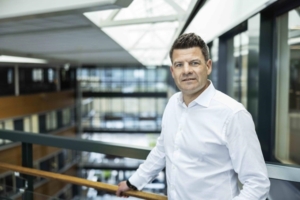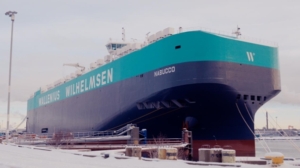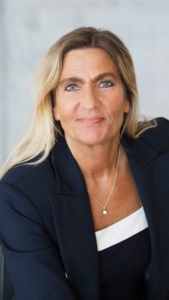Nor-Shipping 2023 Thought Leader Interview – Lasse Kristoffersen, CEO, Wallenius Wilhelmsen


Driving ambition
Lasse Kristoffersen, CEO at Wallenius Wilhelmsen, is on a mission. He doesn’t want to wait for shipping’s green transition, he wants to shape it – collaborating with likeminded partners to decarbonise supply chains and demonstrate possibilities, both with tech and new ways of working. Are you ready for transformation? Let’s roll…
“If Wallenius Wilhelmsen were looking for someone to keep things ticking over they should never have recruited me.” Kristoffersen, six months into his role, after a much-lauded decade as CEO at Torvald Klaveness, doesn’t like wasting time. He’s spent his initial period at the firm getting to know the business and its customers inside out, while presiding over its best ever financial results (his first quarter saw revenue climb 14% and EBITDA climb 41% quarter-on-quarter). This, he quickly notes is “good timing, nothing to do with me” adding that he’ll be “judged on the future”.
An observation that, over the course of the conversation, becomes increasingly difficult to argue with.
Steer the change
Kristoffersen is refreshingly candid for a man in his position – sitting at the helm of the world leader in car transportation and roll-on/roll-off cargo, commanding a fleet of 125 vessels, 15 trade routes to six continents, 120 processing centres and 8,290 staff.
One could argue he has the luxury to be that way; as he himself says, “business is good” and the firm, by his quick estimation, “could probably transport 20% more cars and equipment if we had the capacity to do so.” But more than that, this is just his way of working.
There’s very little ‘bs’, it appears, with Kristoffersen. “I am motivated by transformation,” he states. “That’s what they allowed me to do in Klaveness, with digitalisation and decarbonisation to the fore, and that’s why I’m here now. As the leader in our segment, we have a unique opening to help steer the change in the industry. That was too good an opportunity for me to turn down.”
Keeping promises
So, decarbonisation will be as key to Wallenius Wilhelmsen as it was with Klaveness. But then, to be fair, it already was. Prior to Kristoffersen’s arrival the Norway-headquartered firm made a bold commitment to reduce fleet emissions by 27.5% by 2030. This chimes with his own obvious engagement on the issue.
“I have told myself that I will not leave this industry until I’ve seen it reach zero,” he states. “If it takes me up to 90, I’m not giving up. I am the CEO of one the world’s biggest shipping companies and that gives me a personal responsibility. I have an obligation, and I will not shy away from that.
“Thankfully,” he adds with a smile, “that personal conviction is coupled with the fact that it’s the right thing to do from a business perspective. We see this as a challenge at Wallenius Wilhelmsen, to be sure, but it’s also a huge opportunity.”
The opportunity comes, it seems, through positioning the company as a long-term, fully integrated, ‘green’ logistics partner to its clients, rather than simply a vendor of shipping services. But before we touch on that, let’s revisit those headline environmental targets.
How realistic are they?
Digital meets decarbonisation
“Well, the 27.5% relates to the existing fleet,” he says. “We have a large legacy fleet and, to be honest, they won’t get to zero anytime soon. However, there’s plenty we can do to reduce emissions. That ranges from replacing vessel bulbs, to optimising hulls and propellors, refining operations (adjusting speed for example) and looking at how to integrate new energy sources, such as wind and biofuels. We are actively doing all those things. Then, of course, there’s the digital side.”
Kristoffersen was, he says, “extremely pleased” to discover the advanced digital infrastructure in place on his arrival, with a strong IT platform, cloud computing, and a wealth of sensors installed on vessels to capture real-time operational and performance data. It delivers, he explains, “a connected platform” to roll out energy saving innovations across the fleet.
The first major step in this process was announced in September last year: “We became the first global shipping firm to adopt a fully AI-based approach to vessel optimisation,” he comments, “and this can help reduce fuel consumption on existing vessels by up to 10%. That’s a real step forward.”
The tech is the result of a partnership with Athens-based AI specialist DeepSea. Together the duo have refined a solution that harvests live-steamed data – covering parameters such as fuel consumption, shaft power and speed – and uses a proprietary algorithm to deliver both analysis to onshore teams and instructions to vessel captains on optimising routes and operations.
“It’s digital meets decarbonisation,” Kristoffersen smiles, adding that the roll-out of the solution will be implemented on 65 vessels. But this, it quickly appears, is just the start.
Setting sail
Optimising existing vessels is one thing, but Wallenius Wilhelmsen’s, and Kristoffersen’s, desire to “shape the transformation” involves blazing completely new trails – as demonstrated by the 7,000-car capacity, 220m long, wind-powered Orcelle Wind.
This hugely ambitious project, first spoken of at the World Expo in Japan in 2005, is gradually gathering pace, with EURO 9 million funding from Horizon Europe announced in January and a ‘wing sail’ test rig planned on an existing vessel in 2024. If all goes according to plan, this unique ship, with 40m high sail technology from Oceanbird, will enter operation from late 2026/7.
“It’s a concept with the potential to reduce vessel emissions by up to 90%,” says Kristoffersen. “It obviously raises some eyebrows in the industry, but, in addition to the environmental benefits, there is a strong business case to adopt wind – for relevant trades – as we transition to more expensive, low carbon fuels. Wind will probably not be the main energy source for the industry, but it will be an important part of the mix.
“So, we’re not going to wait around, we’re going to show what’s possible, as soon as possible, with this clean, renewable power source.”
The scheduled arrival of the vessel fits perfectly with another of the company’s new targets – the aim of providing a zero-emission service by 2030.
Linking the chain
Kristoffersen explains: “We’re obviously not talking about company-wide here, but we want to show that it’s possible to have an end-to-end logistics chain with zero emissions – to demonstrate that ‘yes, as an industry we can do this’. The Orcelle Wind will most likely be integral to that offer.”
But it’s far from the only piece of the puzzle. As important as the vessel is, Wallenius Wilhelmsen’s ability to offer a “full spectrum” service to clients is arguably equally critical when it comes to driving down end-to-end emissions. And it is absolutely fundamentally important with respect to the company’s desired positioning as a partner rather than a supplier.
“We work with a lot of car manufacturers,” he notes, before checking his watch and mentioning an upcoming meeting with Tesla. “Our aim with them is not simply to ship the cars, but to build an integrated value chain based on efficiency, transparency and close collaboration. Take NIO for example.”
NIO win situation
The fast-growing Chinese car company works “as one” with Wallenius Wilhelmsen, Kristoffersen says. NIO contracts the shipping firm to collect its cars at the Shanghai port terminal, ship them to Zeebrugge (where Wallenius runs the 10,000-car capacity Orcelle Terminal), check all 12 volt and HV batteries, handle customs clearance duties, move the cars into terminals for further distribution and shipment, and transfer the vehicles onto short-sea vessels bound for ports in the Nordics. And it doesn’t stop there.
In Norway, for example, Wallenius Wilhelmsen brings the vehicles from the port in Drammen to NIO’s central distribution service centre in Oslo, where they’re then ready for the customers.
It’s a collaboration that is increasingly coming to define how Kristoffersen’s firm does business, working hand-in-hand with customers and “moving right up the value chain, much closer to the consumer.”
He notes: “We want to create transparency, connectivity and value, helping our customers manage their supply chains in real-time. This is a ‘win’ for everyone; strengthening our business, delivering visibility and peace of mind for them and, through greater efficiency, helping all stakeholders impact positively on the environment.
“In my mind this is partnership in action.” Which, in conclusion, brings us onto the motivation for our chat today.
Red thread leads to Nor-Shipping
Wallenius Wilhelmsen has just confirmed that it is taking the role of ‘Leading Partner’ at Nor-Shipping 2023, taking place in Oslo and Lillestrøm, 6-9 June.
This is the first time the firm, a stalwart of the Norwegian maritime industry, has signed up as a key sponsor and, Kristoffersen states, much of that has to do with its vision of achieving ambitious goals through collaboration.
“If you consider how we work with customers, how we align with technology suppliers and how we aim to help drive down environmental impact, there’s a clear ‘red thread’. Namely, we do it together. “With Nor-Shipping’s focus on #PartnerShip this year it seemed like the ideal opportunity to increase our commitment and communicate our vision industry-wide.”
He continues: “Nor-Shipping, and events like it, provide a physical environment for global stakeholders to meet, exchange ideas, build understanding and form the partnerships that we need to help shipping evolve. “Time is of the essence,” Kristoffersen concludes, with a quick glance at his watch.
“Now, if you’ll excuse me…” Tesla, and perhaps another profitable #PartnerShip, are waiting for him.
To find out more about Nor-Shipping 2023 and #PartnerShip please see: www.nor-shipping.com

Sidsel Norvik, Director Nor-Shipping
